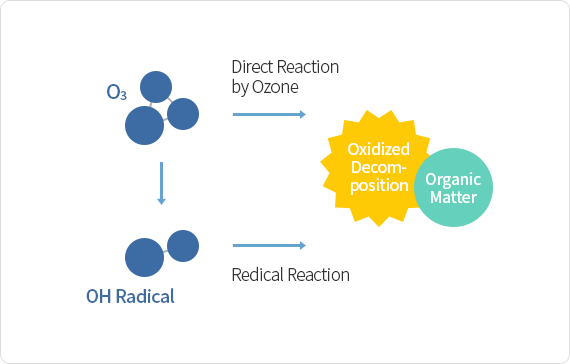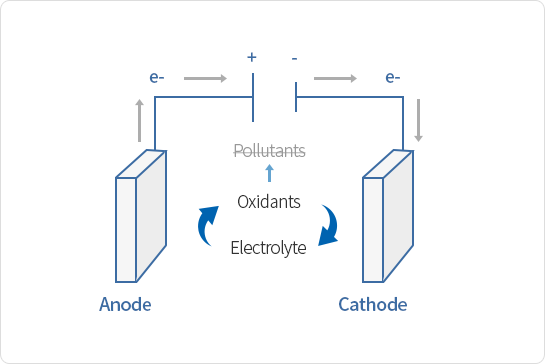AOP (Advanced Oxidation Process)
A process of oxidizing and processing non-biodegradable organic pollutants by creating OH radicals using UV, ozone, H₂O₂, and catalysts
In this technology, the OH radical with strong oxidation power minimizes environmental pollution by decomposing toxic and non-biodegradable organic compounds such as 1,4-Dioxane, Benzene, and Phenol, and by decreasing TOC.
Catalytic Process (Nickel Catalyst)
It drastically promotes chemical oxidation for pre-treatment, post-treatment and reuse.
Advantages
- Minimized use of oxidants
- Easy and reliable operation process
- A wide range of applications
- No sludge
- Conversion of organic matters into eco-friendly components
UV AOP System
A process of removing non-biodegradable organic matters through OH radicals gained from the reaction of UV (Ultra Violet) and oxidants
UV Photolysis (Direct decomposition by light)
UV Oxidation(Decomposition by forming OH radicals)
Ozone Oxidation
A method of removing non-biodegradable organic matters with direct oxidization by ozone and OH radical generated during ozone decomposition
EAOP(Electrochemical Advanced Oxidation Process)
The various oxidants produced in the anode electrode can treat wastewater containing non-degradable organic substances (TOCs).
DSA(Dimensionally Stable Anodes)
- It refers to metal oxide, which is usually applied to the base material.
- It is mainly used for producing sterilizing water as an electrode for generating chlorine.
- The main DSA includes SnO₂, IrO₂, RuO₂, and Pt.
BDD(Boron Doped Diamond)
- It is made of diamonds that are highly chemical stable and durable.
- It is mainly used for the treatment of non-degradable industrial wastewater (secondary batteries, semiconductors, chemicals).
- It is applied to various base materials such as titanium, Niobium, and silicon.
BDD의 우수성
- Compared to DSA electrodes (SnO₂, IrO₂, RuO₂, Pt, etc.) It has excellent electrochemical properties.
- It has an excellent ability to generate oxidizing agents (radicals) with excellent oxidizing power, such as OH∙ and SO₄²⁻∙.
- It has a low coefficient of thermal expansion, excellent abrasion resistance and chemical stability.













